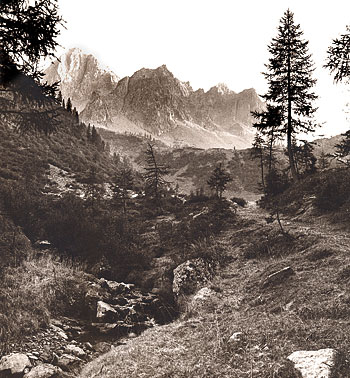 I have no idea why it is that I have loved mountains ever since I was a child. When I was tiny, from the age of three, my parents used to take me to the seaside on holiday, to Pegli, Varazze and Cavi di Lavagna and I used to ask, "why can't we go up to the mountains?".
I have no idea why it is that I have loved mountains ever since I was a child. When I was tiny, from the age of three, my parents used to take me to the seaside on holiday, to Pegli, Varazze and Cavi di Lavagna and I used to ask, "why can't we go up to the mountains?".
I think I must have been fourteen when my father took me skiing on the Mottarone, a peak well known to the inhabitants of Lombardy and at that time always snow-capped. During the Fascist era, schoolchildren were obliged to be members of the O.N.B., the Italian Fascist Youth Movement and being forced to make a choice I enthusiastically chose feathers in my cap and enrolled as an avanguardista in the Pre-Alpine Troops – that gathered every Saturday morning in Piazza General Cantore in Milan, the town of my birth.
Having the good fortune of having a non-fascist father, I hated these parades, but was lucky enough to have a captain by the name of Vittorio Strumolo who, having heard about my skiing abilities first directed me to the Livrio to learn (ascending on foot from Bormio to the Tonale Pass) and then to enrol as a cross-country competitor in Santa Caterina di Valfurla, the Asiago plateau and Mount Resegone.
The results only led to my passion for sport and the mountain becoming even stronger. Thanks to my photographic experiences, this also led me to get to know Brigadier General Giorgio Rigon and I became his loyal friend. This is where the story starts.
Giorgio Rigon was born in Treia (Marches Province) in 1933. He enlisted as an officer in the Alpine forces rising to the rank of Brigadier General.
As a photographer he studies the processes of visual communication, taking a particular interest the artistic movements of the 20th-century.
He writes critical reviews on art and photography for magazines and daily papers.
In 2004 he received the FIAF "Photographer of the Year" – Master of Italian Photography award.
In 1985, he began compiling a photographic history of the Tridentina Alpine Brigade, taking a particular interest in the events surrounding the Russian Campaign.
In accordance with the wishes of the same high command and the support of the Army General Staff, he produced the following historical-photographic works: "The Russian Campaign" and "The Fortress of Francis I".
For something like ten years now, he has been organising conferences on different military issues associated with the First and Second World Wars, with the screening of slides of photographs and documents from that period.
In 2011 he compiled a historical text "The Area of Carnia during the First World War" (La Zona Carnia nella I Guerra Mondiale).
He lives and works in Bressanone.
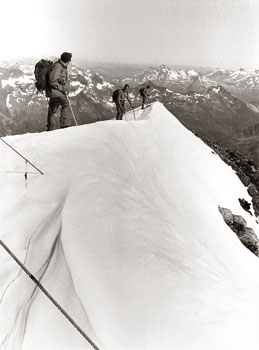 1956: As a second lieutenant in the Alpine forces and a rock-climbing instructor, I observed the legs of the carnic Alpine troops as they climbed so that I could decide which of them could hone their skills into becoming Alpine-Explorers.
1956: As a second lieutenant in the Alpine forces and a rock-climbing instructor, I observed the legs of the carnic Alpine troops as they climbed so that I could decide which of them could hone their skills into becoming Alpine-Explorers.
Good legs, strong, muscular and… hairy. All very admirable and functional in my profession.
Then, during a period of leave by the sea, I began to notice other types of legs, female legs, seaside legs, delicate, sinuous, little accustomed to the stresses of mountaineering and that, when they moved, left beautiful, well-proportioned, variable and dynamic trails in the air. I decided that these were to become the focus of my ongoing search for beauty and so it was to be for many decades.
1981: As a lieutenant colonel, I took charge of the "Val Brenta" Alpine Battalion in Brunico. I was particularly fortunate because the following year marked the Centenary of the forming of the Battalion (the oldest Battalion of the Alpine forces). 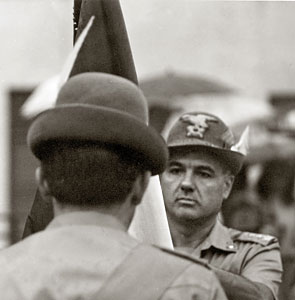 To celebrate the anniversary and remember those who had fallen whilst fighting with a unit that had seen action on the Alps during the First World War, I organised many exercises and Alpine events in the different areas where the "Val Brenta" had seen action in 1916. I focussed in particular on Mount Cauriol in the Lagorai range. In June we conducted simulated attacks on the summit, with one company on the south side (then Italian), another company on the north side (then Austrian) and an Alpine detachment, lead by one of my captains who was an experienced climber who went on to become an Alpine guide, snaking its way along a particularly impassable route to carry out a simulated night-time surprise assault on the summit.
To celebrate the anniversary and remember those who had fallen whilst fighting with a unit that had seen action on the Alps during the First World War, I organised many exercises and Alpine events in the different areas where the "Val Brenta" had seen action in 1916. I focussed in particular on Mount Cauriol in the Lagorai range. In June we conducted simulated attacks on the summit, with one company on the south side (then Italian), another company on the north side (then Austrian) and an Alpine detachment, lead by one of my captains who was an experienced climber who went on to become an Alpine guide, snaking its way along a particularly impassable route to carry out a simulated night-time surprise assault on the summit.
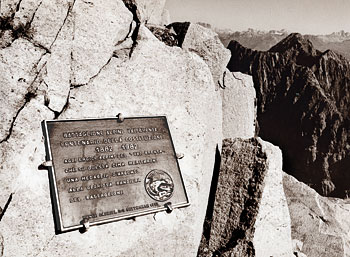 Because the "Val Brenta" battalion had been awarded the Silver Medal for Military valour in 1916, I had a bronze plaque cast. It weighed 30 kg and we took it in turns to carry it on our shoulders up to the summit where it was cemented into the mountain and from where I delivered an address that was broadcast by radio to all the high commands and was also sent to all the units of the Alpine forces.
Because the "Val Brenta" battalion had been awarded the Silver Medal for Military valour in 1916, I had a bronze plaque cast. It weighed 30 kg and we took it in turns to carry it on our shoulders up to the summit where it was cemented into the mountain and from where I delivered an address that was broadcast by radio to all the high commands and was also sent to all the units of the Alpine forces.
I received a wonderful compliment from the then Minister of Defence.

I love to describe myself as a craftsman of the dark room, where I work exclusively with four enlargers, all designed and built by me, in accordance with my criteria of personal 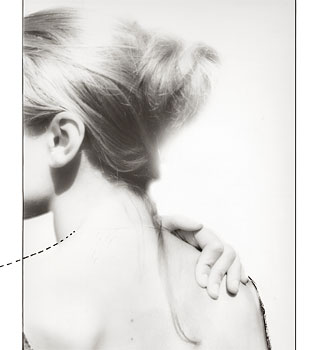 creativity, that in my own way I like to define as: "invention, the ability to manipulate materials, bending the rules, transgression and simplification". My "One true love" is the female form, focussing in particular on the soundless language of gestures and minimal signs that a woman uses to express her very being.
creativity, that in my own way I like to define as: "invention, the ability to manipulate materials, bending the rules, transgression and simplification". My "One true love" is the female form, focussing in particular on the soundless language of gestures and minimal signs that a woman uses to express her very being.
Drawing from the motivations behind the various awards and knowing many of his photographs, I can confirm that his images are not a documentary, but rather, they are sensitive to the female form. So it is that he has always sought to bring refinement to his own expressive needs, not just by lingering on any one linguistic process, but using his enthusiasm which, in my view, gives our Alps, the joy of rock-climbing or walking through the woods and pine forests an atmosphere of purity that transmits to us as users, images that are the joy of living.
FIAF PHOTOGRAPHER OF THE YEAR
"That photography that is not documentary in nature"
(...) His work, characterised by the constant search for brevity and a rigorous sobriety of signs, represents a totally original, idealised symbolism, unique in the world of Italian photography. Giorgio Rigon is a scholar of the processes that lie at the heart of visual communication and an expert on the free expressive potential of the photographic image. His title of "Photographer of the Year 2004" is something that was totally justified and a commendable and well-deserved accolade.
Fulvio Merlak
"What is most striking about Giorgio Rigon's work is its total improbability, if referred to the historical and critical expectations of Italian photography of the period. It is so improbable in fact, that it remains unique because it is characterised by a style that is so subjective that every emulation slides inevitably into imitation. Despite this powerful innovation, his images have the ability of being viewed at every cultural level. They seduce whosoever looks at them, whilst at the same they time stand up to even the most sophisticated critical analysis (…).
His experiences offer us elements highlighting a most original developmental journey that has touched every part of his being. In his own subjectivity, he has experienced inner conflicts that have involved all of his generation. Photography has been the language with which he has succeeded in the arduous task of drawing a harmonious line between his own experience and his deepest poetry.
Silvano Bicocchi
In short, at the conclusion of this invitation to work with "L'Eco delle Dolomiti", a magazine that, because of its content, presentation and layout, I consider fascinating, I am pleased to have chosen Giorgio Rigon not just as an artist but also as a man. I would like to share with the readership, one of his writings that I received along with the many others that tell of his years of Alpine life.
I MUST HAVE SOWN SOMETHINGT
he fact that since 1980 my son, Gabriele, has also chosen to pursue a military career is something that fills me with immense pride. He is an army helicopter pilot and as such has taken part in almost all the missions for peace (or even war) in Namibia, Somalia, Iraq, Afghanistan and the delivering of aid to the Albanians and the Curds.
He too, however, has also found a way of escaping through photography. He too, fascinated by the female form, differs from his father in as much as rather than devote himself to those conceptual and symbolic aspects, he prefers to create images of seduction and eroticism. He works with models of great charm and beauty, establishing a climate of empathy and trust with them, whilst I, less conversational than him and much more timid with women, refuse to work in a studio and continue to shoot furtively and fleetingly.
We were invited to jointly display our photographs and so I decided we should do this under a single heading: "Signs, Calligrams, Symbolisms, Seduction" where the first three words characterise my photographs and the fourth belongs totally to Gabriele.
Giorgio Rigon
 NUMBER 11
NUMBER 11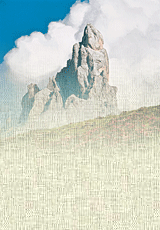
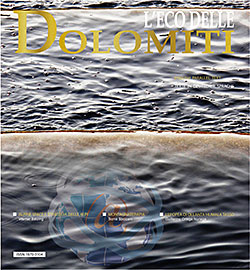
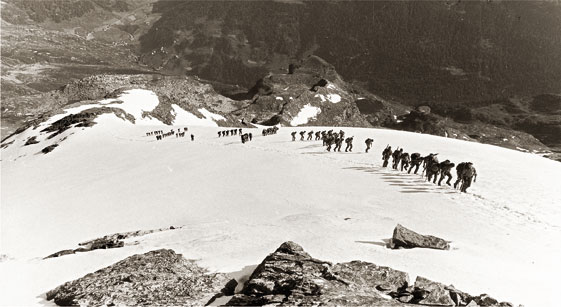
 I have no idea why it is that I have loved mountains ever since I was a child. When I was tiny, from the age of three, my parents used to take me to the seaside on holiday, to Pegli, Varazze and Cavi di Lavagna and I used to ask, "why can't we go up to the mountains?".
I have no idea why it is that I have loved mountains ever since I was a child. When I was tiny, from the age of three, my parents used to take me to the seaside on holiday, to Pegli, Varazze and Cavi di Lavagna and I used to ask, "why can't we go up to the mountains?". 1956: As a second lieutenant in the Alpine forces and a rock-climbing instructor, I observed the legs of the carnic Alpine troops as they climbed so that I could decide which of them could hone their skills into becoming Alpine-Explorers.
1956: As a second lieutenant in the Alpine forces and a rock-climbing instructor, I observed the legs of the carnic Alpine troops as they climbed so that I could decide which of them could hone their skills into becoming Alpine-Explorers.  To celebrate the anniversary and remember those who had fallen whilst fighting with a unit that had seen action on the Alps during the First World War, I organised many exercises and Alpine events in the different areas where the "Val Brenta" had seen action in 1916. I focussed in particular on Mount Cauriol in the Lagorai range. In June we conducted simulated attacks on the summit, with one company on the south side (then Italian), another company on the north side (then Austrian) and an Alpine detachment, lead by one of my captains who was an experienced climber who went on to become an Alpine guide, snaking its way along a particularly impassable route to carry out a simulated night-time surprise assault on the summit.
To celebrate the anniversary and remember those who had fallen whilst fighting with a unit that had seen action on the Alps during the First World War, I organised many exercises and Alpine events in the different areas where the "Val Brenta" had seen action in 1916. I focussed in particular on Mount Cauriol in the Lagorai range. In June we conducted simulated attacks on the summit, with one company on the south side (then Italian), another company on the north side (then Austrian) and an Alpine detachment, lead by one of my captains who was an experienced climber who went on to become an Alpine guide, snaking its way along a particularly impassable route to carry out a simulated night-time surprise assault on the summit. Because the "Val Brenta" battalion had been awarded the Silver Medal for Military valour in 1916, I had a bronze plaque cast. It weighed 30 kg and we took it in turns to carry it on our shoulders up to the summit where it was cemented into the mountain and from where I delivered an address that was broadcast by radio to all the high commands and was also sent to all the units of the Alpine forces.
Because the "Val Brenta" battalion had been awarded the Silver Medal for Military valour in 1916, I had a bronze plaque cast. It weighed 30 kg and we took it in turns to carry it on our shoulders up to the summit where it was cemented into the mountain and from where I delivered an address that was broadcast by radio to all the high commands and was also sent to all the units of the Alpine forces. 
 creativity, that in my own way I like to define as: "invention, the ability to manipulate materials, bending the rules, transgression and simplification". My "One true love" is the female form, focussing in particular on the soundless language of gestures and minimal signs that a woman uses to express her very being.
creativity, that in my own way I like to define as: "invention, the ability to manipulate materials, bending the rules, transgression and simplification". My "One true love" is the female form, focussing in particular on the soundless language of gestures and minimal signs that a woman uses to express her very being.